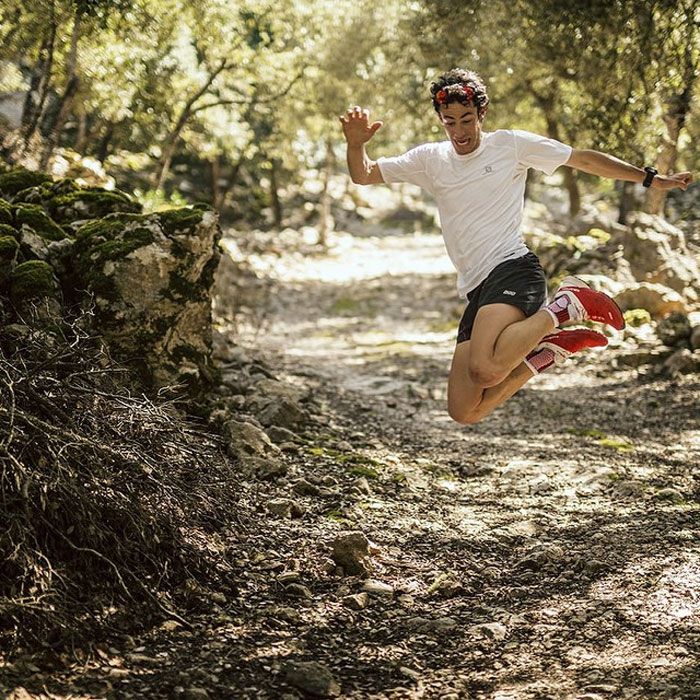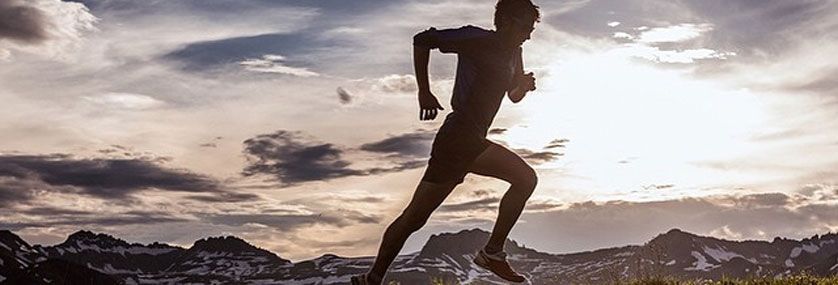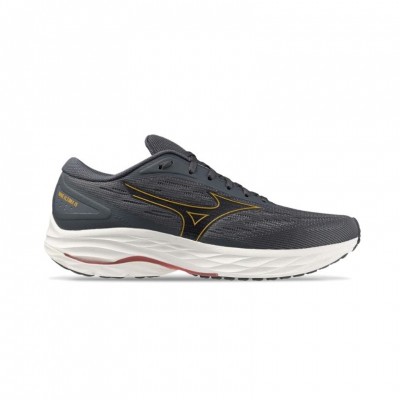Our particular tester of trail running shoes, Dani Oneka, sportsman and multidisciplinary athlete, passionate about the mountains and mountain races, and City Trail guide for the Salomon brand in Bilbao, points out a series of routines that you should take into account, if what you really like is to put on your Running shoes, and go running up and down the mountain.
Listen to our special Trail Running podcast
And I advise you, pen and paper in hand, to take note because Dani offers you several tips for before, during and after each trail running training session.

BEFORE
Hydration
One of the guidelines to which I attach most importance is to hydrate the body properly before any effort, especially in an intense discipline like ours. Every athlete who wants his body to perform well and recover faster must take this important detail into account.
A habit that works for me is to take a bottle everywhere I go and refill it with water. In my case, water is enough to keep my levels full of this important mineral. What I do recommend is a quality bottle that does not leave odors or wear out over time.
Clothing and accessories
Stop for a few minutes to think about what kind of training you are going to do the next day and take into account the time, duration and terrain of the activity. I'm one of those who leave everything prepared the day before, without skimping on the details that can later make the outing more comfortable and safe. It's a matter of being a strategist.
If the outing is from home I only think about what I will need depending on the factors mentioned above. In winter I usually like to cover head and hands that is where the body loses temperature easily. In warmer seasons, cap and extra liquid.
If I travel by car I always prepare a backpack with a full set of spare clothes. Keep in mind that at the end of the activity the first hour is essential to recover the energy lost with fluid intake and food, plus avoid getting cold. These small details will allow you to recover before the next workout and not fall into possible cold that slow down your training.
You may be interested in: City Trail, adventure terrain without leaving the city.
Food and drink
I don't usually eat breakfast a long time in advance, but I do keep in mind to eat easily digestible foods that allow me quick energy without digestive discomfort. Something that works very well for me are vegetable milks (oat, soy, rice, almond, coconut,...) or teas. I accompany with fruit, brown rice pancakes with honey or some sausage, a few nuts and oatmeal. I usually avoid dairy products, sweets and fatty foods. They are slower to digest.
I usually put in my backpack or fanny pack previously tested foods that work for me. In my case: gels, bars, some dark chocolate, magnesium, nuts and raisins. Depending on the intensity of the activity in appropriate proportion.
As for the liquid, I usually leave the water bottles or similar prepared with mineral salts. In addition if the activity is long I take extra salts in powder form or effervescent tablets to refill.
Plan your training well
It is advisable to plan a training program that takes into account your medium to long term goals, your experience, physical aptitudes and sensations. A specific program for you. This will help you to evolve as an athlete and to some extent avoid overload injuries. All the details are important and the advice of a trusted person is very practical. It is not the same to go out to train without an objective than to set programmed goals that take into account the stage you are in. A good programming of your season is very valuable.
If it is a competition, dedicate time that week to review the profile. To plan a good personal race strategy and arrive at the finish line with a good smile on your face, it's a good idea to study that profile. I usually memorize the uphill and downhill sections, taking into account the distance of each of them and their slope. This will give you valuable information to put you in situation especially if you don't know the route. You will know in which sections you should push a little and in which ones you should dose.
Observe where the refreshment posts are located and what type they are (solid, liquid, complete, checkpoints, assistance, ...) The more thorough you are, the more planned you will have the race and avoid possible mishaps. It is also convenient within the race to set small goals of distance or summits. Small goals that motivate you to achieve them. It is different to go out thinking only about finishing than to plan the small steps to take. It will be less expensive and more objective, as well as motivating.
Choosing the right shoes
One of the factors that in my opinion avoids injuries is to have a good closet of shoes for different conditions and even different brands. At the beginning it's a good idea to try different brands and models. Little by little you will choose one or the other.
You may be interested in: Trail running shoes
Having a good selection of shoes is a great advantage. It is preferable to save on other aspects of our daily life but spending on good equipment for our mountaineering activity will surely give you a plus of sporting health and adapt to all terrains, distances and conditions.

DURING
Warm up
It is necessary to give the body some time to take temperature, joint and muscular elasticity, as well as an adaptation of the different apparatuses to the physical activity. 15-20 very gentle minutes are advisable.
If the temperature is very cold, it is advisable to cover up and spend more time warming up.
In the case of a competition in which you already go out with a certain intensity, you will have to pay special attention to prepare your body for this effort beforehand. You can start with 15' of gentle jogging, joint movements and a little gentle muscle conditioning, to finish with some progressions or straights from less to more finishing at an intense pace in short distances. All of this will raise your temperature and wake up your heart rate for the race.
Drink and eat
The theory of drinking and eating gradually is the most correct, but how much depends on your experience and ability. In the mountains it is advisable to drink and eat every 45 minutes to avoid or extend as much as possible a sudden fatigue.
It will depend on the level and experience of each person and the duration of the exercise. That is to say, if you are only going to run for 1 hour in the mountains, you can hold on without taking anything until the end. However, if it is extended to several hours, it is necessary to program the intakes well so that there is continuity. The more we balance the wear and tear that our body is suffering, the better condition it will be in after a few kilometers.
A diet adapted to our level and conditions will not only help us to finish in good condition but also to recover better for future training sessions.
Feelings
Regardless of the intentions and level of each athlete, you have to listen to yourself. Running by sensations is a smart way to give your body proportionally what it asks for and enjoy the activity.
On the other hand, if you are preparing for a competition or want to progress in your level, it will be time to make some extra efforts to evolve. But you should not neglect your personal feelings either. When I feel good and everything flows, I let go more intensely. When the opposite happens to me, I adapt to the needs that my body asks of me. On these occasions, when the body doesn't go along with your intentions, you also learn to overcome "bad days" and find the strength to surpass yourself.
Dosing distance and elevation gain
The pace and duration of the activity in the mountains will depend largely on the positive and negative slope. Combine fast workouts with little elevation gain and those with a significant accumulated elevation gain, improve on downhills, flats and climbs, muddy or rocky terrain, ... will be the key to becoming a more complete runner.
Both the athletic quality in easy running areas and learning to manage well the strong and long uphill or downhill sections are factors to be taken into account.
It is also advisable to dose the days and intensity of training. To do this, get a person you trust to advise you properly. Otherwise, the impetus to train every day and the lack of rest can work against you.
Enjoy and play
It is common for us to have fixed circuits or regular training zones in which we can compare our performance over time. In other words, a training routine that allows you to evolve.
But it is also convenient to disconnect a little and not forget the privilege of our activity, which is to move through nature. A living habitat that changes with the seasons and offers us different costumes to adapt to and enjoy. Let yourself go, improvise and change your routines. Look for new challenges, shortcuts, corners,...

AFTER
Recovery
It is as important as physical activity, to take into account the rest periods. We have all had the feeling of wasting time when we do not train and even think that the ideal weight of each one is going to go down the drain. Wrong!
Recovery starts the very instant you finish running. Cover yourself, hydrate and feed yourself accordingly.
Nowadays there are specific recovery preparations from different brands to replenish your losses. They usually contain different proportions of carbohydrates, proteins and vitamins. All of them are necessary to balance the loss of salts, regenerate your muscles and strengthen the immune system, the latter quite unprotected once you have finished a long ride.
Just as we have taken our time warming up to activate the body, it is also advisable to dedicate about 10' of very gentle jogging at the end of each workout, to convey to the body and mind that the intensity is over and relaxation has begun.
Once your losses have been replenished, you should relax your muscles with a good session of gentle stretching to restore the system to its proper tone. A hot shower with cold contrast in the lower extremities helps to improve the feeling of tiredness or muscular fatigue.
The hours of sleep will condition your athletic performance. During the night your body rests and regenerates. These are necessary hours and part of every athlete's training.
It's not all about going out to train in the mountains.
Program also in each week total rest days, long rest periods at the end of the season, active recovery and cross-training or practice of those alternative disciplines that generate performance but with less muscle load and impact of the specific musculature of mountain running (swimming, biking, skating, skiing, ...).
Analyze and record data
It is interesting to have a record of your training data and give valor to the information that our body offers us about how it adapts day by day, interpreting not only the response to training but also what is worth and what is not worth.
This objective data is provided by the use of a heart rate strap that records an accurate reading of your prime mover and transfers it to your sports watch.
At the time of training, it guides us and shows us the right path, as long as we have notions or a professional advises us on which bands we should train in each moment to have an optimal performance and evolution.
After training, it is interesting to interpret the relationship between the different training data transferred to the PC. It is the most objective information of your body response. Add to this your sensations and the equipment/food tests. Draw conclusions, recover as soon as possible and get enough rest.
Nowadays there are Heart Rate Monitors & Sports Watches that offer us data numbers but we must take the time to interpret them and take advantage of them.
A stress test every so often in front of a doctor is like the MOT check-up in which the general condition of the vehicle is assessed. It will give us the parameters on which to base future training, the improvement that our body has over time and the physical response of the device to intense effort.
Social Networking
A good way to share what we like the most and relate them. One of the great advantages of our sport is that it takes place in nature, which offers us a multitude of costumes, lights and contrasts, places, ....
It is bio-diverse. The photographic possibilities are equally so, but so is our responsibility towards it.
It is everyone's responsibility to reduce our footprint to a minimum, with the least possible impact, and to the same extent, to improve it.
Photo credit: Salomon Running Instagram/@jsaragossa
Read more news about: Running Training



















